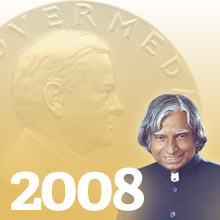Dr. APJ Abdul Kalam

Dr. APJ Abdul Kalam, 2008 Hoover Medal Recipient
Dr. Avul Pakir Jainulabdeen Abdul Kalam was born on October 15, 1931, in Tamil Nadu, India. A preeminent scientist, a gifted engineer, and a true visionary, this past president of India is also a humble humanitarian in every sense of the word. Dr. Kalam’s meteoric rise from extremely modest beginnings to the highest levels of science and technology in India’s successful space and defense programs and ultimately to the position of the country’s universally admired and respected president, is the stuff of which legends are made.
Upliftment of the rural population of India has always been of prime concern to Dr. Kalam. Many of the projects that Dr. Kalam launched during his career have been ingeniously designed to bring some of the advantages of our modern world to the remote and economically deprived segments of the Indian population at an affordable price. A prime example is the key role Dr. Kalam played in the creation of “telemedicine,” a system that helps connect rural hospitals with super-specialty medical centers in India and abroad. The success of this project proved that it is indeed possible to bring cutting edge medical care to even the most isolated rural areas.
Yet another of Dr. Kalam’s spectacular achievements has been the establishment of the Society of Biomedical Technology (SBMT) in 1993. This initiative that provided diverse opportunities to several million people was designed to combine Indian defense technology of which Dr. Kalam was the master, with local medical expertise to produce state-of-the-art medical equipment and low cost consumables that were previously being imported at steep rates. Some of SBMT’s successful products include a coronary stent christened Kalam-Raju stent, an ophthalmic laser and medical calipers.
One of Dr. Kalam’s ambitious projects that is close to his heart is PURA (Providing Urban Amenities in Rural Areas), a public-private enterprise that works by improving four types of “connectivities”; physical connectivity with better roads, electronic connectivity with reliable communication, knowledge connectivity with better education and finally all integrated to create economic connectivity and growth. Four PURA units, composed of committed teams are already in progress and many more are in the process of development.
As a part of his plan to promote national development by inspiring young minds, Dr. Kalam has been tirelessly traveling across the country and speaking to students all over India. This has made him a beloved figure in every corner of the land.
A very interesting aspect of his scholastic side is his literary pursuit. Dr. Kalam is the author of a number of books, such as Wings of Fire, India 2020 - A Vision for the New Millennium, My Journey, Ignited Minds - Unleashing The Power Within India, Indomitable Spirit, Guiding Soul, Envisioning an Empowered Nation, Inspiring Thoughts, Children Ask Kalam, You Are Born To Blossom, and Life Tree. Many of these books have become household names in India and among Indian nationals abroad. They have been translated into many Indian and foreign languages.
Dr. Kalam, one of the most distinguished scientists of India, has the unique honor of receiving honorary doctorates from 36 universities and institutions. Dr. Kalam has received the coveted civilian awards Padma Bhushan (1981) and Padma Vibhushan (1990), and the highest civilian honor Bharat Ratna (1997). He is a recipient of several other awards and a fellow of many professional institutions.
The Royal Society of UK awarded him the King Charles-II Medal for Science and Technology in October 2007.
Dr. Kalam became the 11th President of India on 25th July 2002. After a full five year term His Excellency retired from office on 25th July 2007 to enter an even more active public service.
Dr. Kalam’s current mission is to transform India into a fully developed nation by 2020.